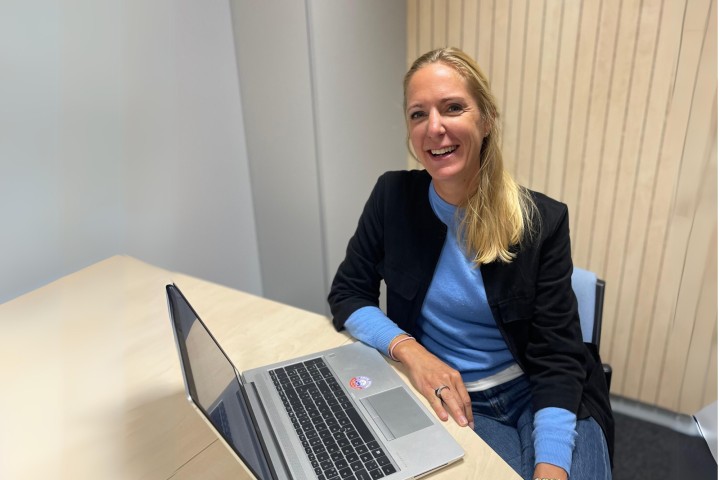Purposeful communication: How to take your conversation to the next level
Back to overview-
Digital Marketing
In a world where there is a constant overload of brands and influencers telling us to buy, work, eat, dress, live a certain way, it’s hard to make your message break through. But there’s good news: the people and companies that stand out in the crowd aren’t necessarily the ones with the loudest voices, or the ones with the most resources. The messages that really make an impact are those that tell a moving story. In the latest Beyond Digital session, Katleen Dewaele, Executive Communications Lead at Microsoft, shares how purposeful storytelling can take your communication to the next level, both in business and interpersonal settings.
“Purposeful and authentic storytelling is so impactful because people want to relate to a real person, not to a faceless company."
Katleen Dewaele, Executive Communications Lead @ Microsoft
Authenticity starts with knowing yourself
“Purposeful communication has to come from a place of authenticity,” Katleen says, “and that means knowing yourself.” Self-knowledge doesn’t stop at doing a SWOT-analysis, however.
“Whether you’re looking at yourself as a person or at your company or brand, you need to be aware of your purpose, your ‘Why’. What drives you to do what you do? What impact are you trying to make for your customers, or for the world around? What are your values?”
Of course having a bigger-picture purpose doesn’t mean that your company can’t be for-profit. “Even the most noble organizations need to keep their bottom line into account in order to survive, and that’s OK,” Katleen clarifies. “But when we’re talking about purposeful communication, profit probably shouldn’t be your ‘why’.”
Reflecting on your own purpose alongside your company’s purpose allows you to make sure that your personal values are reflected in your company’s values.
(Want to join the next meeting of Beyond Digital to learn, share and shape the future of digital in Belgium? Sign up for more information here!)

And your place of work shouldn’t be the only choice guided by your purpose. “Whether it’s in our professional careers, the way we give shape to family and social life, and how we approach other personal projects, our purpose should be informing all of our actions and decisions,” Katleen adds. “That’s what it really means to know and live your why, and that is what will make you feel authentic, to yourself as well as to others.”
This isn’t something to implement once, and then sit back. “In personal life as well as in business, this is a continuous process. Not only because you’re never done discovering new things about yourself or your company,” Katleen explains, “but also because life is inherently full of changes that can impact your why and your company values. You can’t really be honest with yourself about your purpose, if you’re not open to keep getting to know yourself better.”
For a business, authenticity also means letting your purpose shine through in all layers. Katleen: “If your brand is all about honesty and transparency, you need to live up to this through transparent internal communication, honest customer service, a transparent hiring policy, and everywhere else. Otherwise it’s just an empty message, and that’s far from authentic.
Embrace imperfections
It can be scary to embrace your purpose, if it makes you aware of your flaws. “Fortunately, perfection is not a condition for being authentic,” Katleen comforts. “Perfectionism is even detrimental to authenticity. Everybody and every company has flaws and makes mistakes, and acknowledging them is just a part of being honest with yourself.”
Besides, this vulnerability is what makes us relatable, she adds. “As humans, we are wired to want to relate to other humans. Think about it – isn’t it much more compelling to buy a product or service from a real person, instead of from a robot or a faceless company?” Being authentic, even if your flaws show, is what makes you human. And that’s how trust is built.
But what does that look like in practice? “An example that comes to mind, would be when a customer service agent gets a complaint from a user and acknowledges that the product isn’t perfect, or maybe even that they made a mistake,” Katleen says. “This way the customer feels heard and also knows that they’re talking to a real, empathetic human, not a robot.”
It makes sense that as a society, we don’t love acknowledging our mistakes. “Through our upbringing and education, we are taught to avoid failure as if it’s the end of the world. Sometimes we’re even punished when we fail.” Such a shame, according to Katleen: “Personally, I prefer to say ‘fall’ instead of ‘fail’, because it reminds me that I can get back up and try again. And by allowing yourself to be imperfect and to make mistakes, you can learn so much more, not only in getting back up, but also simply because you’ll stop holding yourself back. Embracing imperfection is freeing.”

Empathetic communication is a two-way street
If you’ve embraced your purpose and your flaws, and you’ve crafted compelling and purposeful messages for your storytelling, it’s easy to think that you’re done. But don’t fall into this trap. “As a company, you always have to remember that the real heroes are the customers,” Katleen emphasizes. “So you have to keep putting them front and centre and listen to their feedback in an empathetic way. That includes making an effort to understand their personal and cultural context, which will definitely influence how they relate to your product or service.”
“At Microsoft we do this through asking for honest feedback even after a client decides to leave us, for example. You can really only be a good communicator if you’re also a good listener. Don’t assume that you already know what they’re thinking, but be open to learning about where they’re coming from.”
Nobody said it would be easy
If it sounds like there’s a lot that goes into ‘simply being authentic’, then that’s true, Katleen confirms. “But you don’t have to worry that you’re overdoing it. It’s tempting to think that being authentic should be effortless. But communication in general, and purposeful communication especially, takes a lot of thought. If you don’t craft your message carefully, you could say or do something that doesn’t align with your values at all, that haunts your brand image for years,” Katleen: “For illustration, even the most authentic leaders will have their speeches rewritten up to twelve or more times. Winging it isn’t necessarily more authentic,” she assures us.
“The biggest threat to purposeful communication won’t be that your authenticity is engineered, but that you don’t practice what you preach.”

Want to join in on the discussion? Ariad’s digital professionals knowledge sharing club Beyond Digital brings together future-forward individuals working across industries in the largest brands in Belgium. No member fees, just a community of ambitious minds! Apply here for more information about this monthly event.



